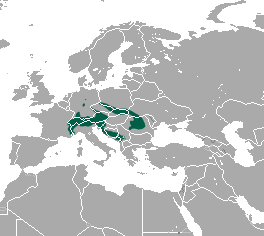
Orthohantavirus is a genus of single-stranded, enveloped, negative-sense RNA viruses in the family Hantaviridae within the order Bunyavirales. Members of this genus may be called orthohantaviruses or simply hantaviruses.

The red-toothed shrews of the subfamily Soricinae are one of three living subfamilies of shrews, along with Crocidurinae and Myosoricinae. In addition, the family contains the extinct subfamilies Limnoecinae, Crocidosoricinae, Allosoricinae and Heterosoricinae. These species are typically found in North America, northern South America, Europe and northern Asia. The enamel of the tips of their teeth is reddish due to iron pigment. The iron deposits serve to harden the enamel and are concentrated in those parts of the teeth most subject to wear. Members of the genera Chimarrogale, Nectogale, Neomys (Nectogalini) and some members of Sorex (Soricini) are known as water shrews, due to having a semi-aquatic lifestyle.

The American pygmy shrew, also called the eastern pygmy shrew, is a small shrew found throughout much of Alaska, Canada, and the northern contiguous United States, as well as south along the Appalachian Mountains and in a small region in the Colorado and Wyoming Rockies. The species was first discovered in 1831 by naturalist William Cane in Georgian Bay, Parry Sound.

The genus Sorex includes many of the common shrews of Eurasia and North America, and contains at least 142 known species and subspecies. Members of this genus, known as long-tailed shrews, are the only members of the tribe Soricini of the subfamily Soricinae. They have 32 teeth.

The Eurasian pygmy shrew, often known simply as the pygmy shrew, is a widespread shrew of the northern Palearctic.

The Eurasian least shrew, also called the lesser pygmy shrew, is the second-smallest mammal by mass after the Etruscan shrew.
Andes virus (ANDV) is the most common cause of hantavirus pulmonary syndrome (HPS) in South America. Andes virus is transmitted mainly by the long-tailed pygmy rice rat. In its natural reservoir, ANDV causes an asymptomatic, persistent infection and is spread through excretions, fighting, and grooming. Humans can become infected by inhaling aerosols that contain rodent saliva, urine, or feces, as well as through bites and scratches. In humans, infection leads to HPS, an illness characterized by an early phase of mild and moderate symptoms such as fever, headache, and fatigue, followed by sudden respiratory failure. The case fatality rate from infection is high, at about 40%.

The alpine shrew is a species of mammal in the family Soricidae. It is found in the alpine meadows and coniferous forests of central and southern European mountain ranges.

The montane shrew is a species of mammal in the family Soricidae commonly known as the dusky shrew. Monticolus is derived from the Latin root word mons meaning mountain. It is found in Alaska, western Canada, the western United States in Washington, Idaho, Montana, Utah, Colorado, New Mexico, Arizona, Oregon, Nevada, and California, as well as in Mexico.

Preble's shrew is a small shrew distributed across the Great Basin of the United States and southern British Columbia in Canada.

Tupaia is a treeshrew genus in the family Tupaiidae that was first described by Thomas Stamford Raffles in 1821.
Azagny virus (AZGV) is an Orthohantavirus found in West African pygmy shrews. The virus was named after the Azagny National Park, where some sample collecting occurred.
Sangassou orthohantavirus(SANGV) is single-stranded, negative-sense RNA virus species of the genus Orthohantavirus in the Bunyavirales order. It was first isolated in an African wood mouse (Hylomyscus simus) in the forest in Guinea, West Africa in 2010. It is named for the village near where the mouse was trapped. It is the first indigenous Murinae-associated African hantavirus to be discovered.
Thottopalayam thottimvirus, formerly Thottapalayam virus, (TMPV) is single-stranded, enveloped, negative-sense RNA virus species of the genus Thottimvirus in the Bunyavirales order. It is the first hantavirus to be isolated from a shrew. It was discovered in India in 1964.
Imjin thottimvirus(MJNV) is a single-stranded, enveloped, negative-sense RNA virus of the orthohantavirus genus in the Bunyavirales order. It is a newly identified hantavirus isolated from the lung tissues of Ussuri white-toothed shrews of the species Crocidura lasiura (order Soricomorpha, family Soricidae, subfamily Crocidurinae) captured near the demilitarized zone in the Republic of Korea during 2004 and 2005.
Nova virus is a single-stranded, negative-sense, enveloped RNA virus with a trisegmented genome. It belongs to one of the most divergent lineages of the hantavirus group, which consists of zoonotic viruses belonging to the family Bunyaviridae. As of now, no human cases of infection have been reported.
Rockport virus (RKPV) is a single-stranded, enveloped, negative-sense RNA orthohantavirus.
Asama orthohantavirus(ASAV), also called Asama virus, is a single-stranded, enveloped, segmented negative-sense RNA hantavirus. The hantavirus was isolated in Japan from Japanese shrew mole. Hantaviruses harbored by shrews are genetically closer to ASAV than to hantaviruses harbored by rodents. Host-switching may be evident in the future due to the viruses closeness to soricine shrew-borne hantaviruses. The detection of the ASAV was the first hantavirus found to be hosted by members of the family Talpidae, which includes shrew moles. Thoughts on hantavirus evolutionary history has expanded due to the discovery of ASAV.
Oxbow virus(OXBV) is a single-stranded, enveloped, negative-sense RNA orthohantavirus.









